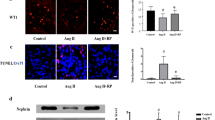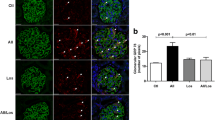Abstract
Background
Podocyte damage exerts a key role in proteinuria. We have demonstrated that calcineurin-binding protein 1 (Cabin1) upregulated during podocyte injury, yet its function in podocyte is still unclear.
Methods
We established 5/6 nephrectomized rats and angiotensin II (AngII)-injured podocyte, as well as knocked down Cabin1 with siRNA in cultured podocytes. Rats were killed at 4 or 8 weeks after 5/6 nephrectomy. The localization of podocyte cytoskeleton was detected after immunofluorescence staining. Podocyte mitochondrial morphology was observed under electron microscopy. Podocyte mitochondrial transmembrane potential (MMP) was measured with MitoCapture kit. Cabin1 and cytochrome c protein expression were detected by western blot.
Results
Massive proteinuria, as well as obvious segmental glomerular sclerosis, was found in rats at 8 weeks after nephrectomy, accompanied with the disruption of synaptopodin. Moreover, mitochondria changed from large and ellipsoid shape to the small, long, and irregular shape in rats at 4 weeks after operation. At 8 weeks, mitochondria were swollen and cristae were remarkably dissolved. Compared to sham-operated rats, Cabin1 protein expression was obviously upregulated in rats at 8 weeks. AngII induced the decrease in MMP, as well as the overexpression of Cabin1 and cytochrome c protein in podocytes. Knocking down Cabin1 induced the disruption of F-actin and overexpression of cytochrome c (1.81 ± 0.21 in siRNA group vs. 0.86 ± 0.11 in negative control group).
Conclusions
Knocking down Cabin1 induces the disruption of cytoskeleton and mitochondrial dysfunction in podocyte. Cabin1 could be a crucial factor in podocyte damage.









Similar content being viewed by others

References
Grahammer F, Schell C, Huber TB (2013) The podocyte slit diaphragm-from a thin grey line to a complex signalling hub. Nat Rev Nephrol 9:587–598
Roeder SS, Barnes TJ, Lee JS, Kato I, Eng DG, Kaverina NV, Sunseri MW, Daniel C, Amann K, Pippin JW, Shankland SJ (2017) Activated ERK1/2 increases CD44 in glomerular parietal epithelial cells leading to matrix expansion. Kidney Int 91:896–913
Chang YC, Hsu SY, Yang CC, Sung PH, Chen YL, Huang TH, Kao GS, Chen SY, Chen KH, Chiang HJ, Yip HK, Lee FY (2016) Enhanced protection against renal ischemia-reperfusion injury with combined melatonin and exendin-4 in a rodent model. Exp Biol Med (Maywood) 241:1588–1602
Imasawa T, Rossignol R (2013) Podocyte energy metabolism and glomerular diseases. Int J Biochem Cell Biol 45:2109–2118
Su M, Dhoopun AR, Yuan Y, Huang S, Zhu C, Ding G, Liu B, Yang T, Zhang A (2013) Mitochondrial dysfunction is an early event in aldosterone-induced podocyte injury. Am J Physiol Ren Physiol 305:F520–F531
Zhao M, Yuan Y, Bai M, Ding G, Jia Z, Huang S, Zhang A (2016) PGC-1α overexpression protects against aldosterone-induced podocyte depletion: role of mitochondria. Oncotarget 7:12150–12162
Abe Y, Sakairi T, Beeson C, Kopp JB (2013) TGF-β1 stimulates mitochondrial oxidative phosphorylation and generation of reactive oxygen species in cultured mouse podocytes, mediated in part by the mTOR pathway. Am J Physiol Ren Physiol 305:F1477–F1490
Wen Y, Zhou P, Liu L, Wang Z, Zhang Y, Liang J (2016) Effect of the knockdown of Cabin1 on p53 in glomerular podocyte. J Recept Signal Transduct Res 36:173–180
Wen Y, Liu L, Zhou P, Li H, Wang Z, Zhang Y, Liang J (2016) Tacrolimus restores podocyte injury and stabilizes the expression of Cabin1 in 5/6 nephrectomized rats. Ren Fail 38:564–570
Schonenberger E, Ehrich JH, Haller H, Schiffer M (2011) The podocyte as a direct target of immunosuppressive agents. Nephrol Dial Transplant 26:18–24
Faul C, Donnelly M, Merscher-Gomez S, Chang YH, Franz S, Delfgaauw J, Chang JM, Choi HY, Campbell KN, Kim K, Reiser J, Mundel P (2008) The actin cytoskeleton of kidney podocytes is a direct target of the antiproteinuric effect of cyclosporine A. Nat Med 14:931–938
Zhang Q, Shi SF, Zhu L, Lv JC, Liu LJ, Chen YQ, Zhang H, Wang HY (2012) Tacrolimus improves the proteinuria remission in patients with refractory IgA nephropathy. Am J Nephrol 35:312–320
Liao R, Liu Q, Zheng Z, Fan J, Peng W, Kong Q, He H, Yang S, Chen W, Tang X, Yu X (2015) Tacrolimus protects podocytes from injury in lupus nephritis partly by stabilizing the cytoskeleton and inhibiting podocyte apoptosis. PLoS ONE 10:e0132724
Estaquier J, Vallette F, Vayssiere JL, Mignotte B (2012) The mitochondrial pathways of apoptosis. Adv Exp Med Biol 942:157–183
Hoppins S (2014) The regulation of mitochondrial dynamics. Curr Opin Cell Biol 29:46–52
Shen L, Chen C, Wei X, Li X, Luo G, Zhang J, Bin J, Huang X, Cao S, Li G, Liao Y (2015) Overexpression of ankyrin repeat domain 1 enhances cardiomyocyte apoptosis by promoting p53 activation and mitochondrial dysfunction in rodents. Clin Sci (Lond) 128:665–678
Mallipattu SK, Horne SJ, D’Agati V, Narla G, Liu R, Frohman MA, Dickman K, Chen EY, Ma’Ayan A, Bialkowska AB, Ghaleb AM, Nandan MO, Jain MK, Daehn I, Chuang PY, Yang VW, He JC (2015) Kruppel-like factor 6 regulates mitochondrial function in the kidney. J Clin Invest 125:1347–1361
Guan N, Ren YL, Liu XY, Zhang Y, Pei P, Zhu SN, Fan Q (2015) Protective role of cyclosporine A and minocycline on mitochondrial disequilibrium-related podocyte injury and proteinuria occurrence induced by adriamycin. Nephrol Dial Transplant 30:957–969
Gucer S, Talim B, Aşan E, Korkusuz P, Ozen S, Unal S, Kalkanoğlu SH, Kale G, Cağlar M (2005) Focal segmental glomerulosclerosis associated with mitochondrial cytopathy: report of two cases with special emphasis on podocytes. Pediatr Dev Pathol 8:710–717
Anderson M, Roshanravan H, Khine J, Dryer SE (2014) Angiotensin II activation of TRPC6 channels in rat podocytes requires generation of reactive oxygen species. J Cell Physiol 229:434–442
Hamilton DJ, Zhang A, Li S, Cao TN, Smith JA, Vedula I, Cordero-Reyes AM, Youker KA, Torre-Amione G, Gupte AA (2016) Combination of angiotensin II and l-NG-nitroarginine methyl ester exacerbates mitochondrial dysfunction and oxidative stress to cause heart failure. Am J Physiol Heart Circ Physiol 310:H667–H680
Boatright KM, Salvesen GS (2003) Mechanisms of caspase activation. Curr Opin Cell Biol 15:725–731
Eisenreich A, Langer S, Herlan L, Kreutz R (2016) Regulation of podoplanin expression by microRNA-29b associates with its antiapoptotic effect in angiotensin II-induced injury of human podocytes. J Hypertens 34:323–331
Peng J, Li X, Zhang D, Chen JK, Su Y, Smith SB, Dong Z (2015) Hyperglycemia, p53, and mitochondrial pathway of apoptosis are involved in the susceptibility of diabetic models to ischemic acute kidney injury. Kidney Int 87:137–150
Hammond DR, Udvadia AJ (2010) Cabin1 expression suggests roles in neuronal development. Dev Dyn 239:2443–2451
Vashistha H, Meggs L (2013) Diabetic nephropathy: lessons from the mouse. Ochsner J 13:140–146
Jang H, Choi SY, Cho EJ, Youn HD (2009) Cabin1 restrains p53 activity on chromatin. Nat Struct Mol Biol 16:910–915
Choi SY, Jang H, Roe JS, Kim ST, Cho EJ, Youn HD (2013) Phosphorylation and ubiquitination-dependent degradation of CABIN1 releases p53 for transactivation upon genotoxic stress. Nucleic Acids Res 41:2180–2190
Wen Y, Wang Z, Liu L, Zhang Y, Zhou P, Liang J (2015) Cabin1 localizes in glomerular podocyte and undergoes nuclear translocation during podocyte injury. Ren Fail 37:1344–1348
Funding
This study was supported by Health and Family Planning General Guidance Project of Guangzhou, China (Grant Nos. 20161AO11073 and 20161AO11074) and Doctoral Program Foundation of Guangzhou Medical University, China (Grant No. 2014C33).
Author information
Authors and Affiliations
Corresponding author
Ethics declarations
Conflict of interest
The authors declare that they have no conflict of interest.
Ethical approval
All applicable international, national, and/or institutional guidelines (Animal Ethics Committee of Guangdong Province) for the care and use of animals were followed.
Rights and permissions
About this article
Cite this article
Wen, Y., Liu, L., Xu, Q. et al. Knocking down Cabin1 induces glomerular podocyte injury. Int Urol Nephrol 50, 983–991 (2018). https://doi.org/10.1007/s11255-018-1787-z
Received:
Accepted:
Published:
Issue Date:
DOI: https://doi.org/10.1007/s11255-018-1787-z



